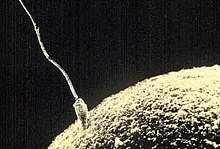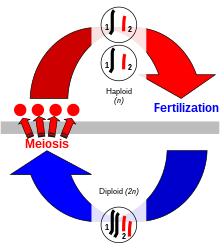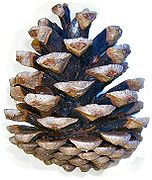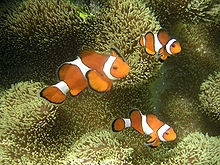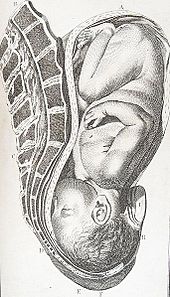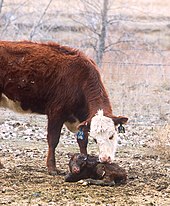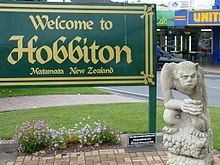The Lord of the Rings
|
|
| Author |
J. R. R. Tolkien |
| Country |
England |
| Language |
English |
| Genre |
|
| Publisher |
George Allen & Unwin (UK) |
| Published |
- 29 July 1954
- 11 November 1954
- 20 October 1955
|
| Media type |
Print (hardback & paperback) |
| Preceded by |
The Hobbit |
The Lord of the Rings is an
epic high-fantasy novel written by English author
J. R. R. Tolkien. The story began as a sequel to Tolkien's 1937 fantasy novel
The Hobbit, but eventually developed into a much larger work. Written in stages between 1937 and 1949, much of it during
World War II,
[1] The Lord of the Rings is one of the
best-selling novels ever written, with over 150 million copies sold.
[2]
The title of the novel refers to the story's main
antagonist, the
Dark Lord Sauron,
[note 1] who had in an earlier age created the
One Ring to rule the other
Rings of Power as the ultimate weapon in his campaign to conquer and rule all of
Middle-earth. From quiet beginnings in the
Shire, a
hobbit land not unlike the English countryside, the story ranges across northwest Middle-earth, following the course of the
War of the Ring through the eyes of its characters, the hobbits
Frodo Baggins,
Samwise "Sam" Gamgee,
Meriadoc "Merry" Brandybuck and
Peregrin "Pippin" Took, but also the hobbits' chief allies and travelling companions: the
Men Aragorn, a
Ranger of the North, and
Boromir, a Captain of
Gondor;
Gimli, a
Dwarf warrior;
Legolas, an
Elven prince; and
Gandalf, a
Wizard.
The work was initially intended by Tolkien to be one volume of a two-volume set, the other to be
The Silmarillion, but this idea was dismissed by his publisher.
[4][5] For economic reasons
The Lord of the Rings was published in three volumes over the course of a year from 29 July 1954 to 20 October 1955.
[4][6] The three volumes were titled
The Fellowship of the Ring,
The Two Towers, and
The Return of the King. Structurally, the novel is divided internally into six books, two per volume, with several appendices of background material included at the end of the third volume. Some editions combine the entire work into a single volume.
The Lord of the Rings has since been reprinted numerous times and
translated into many languages.
Tolkien's work has been the subject of
extensive analysis of its themes and origins. Although a major work in itself, the story was only the last movement of a larger epic Tolkien had worked on since 1917,
[7] in a process he described as
mythopoeia.
[citation needed] Influences on this earlier work, and on the story of
The Lord of the Rings, include philology, mythology, religion and the author's distaste for the effects of industrialization, as well as earlier fantasy works and Tolkien's experiences in
World War I.
[1] The Lord of the Rings in its turn is considered to have had a great effect on modern fantasy; the impact of Tolkien's works is such that the use of the words "Tolkienian" and "Tolkienesque" has been recorded in the
Oxford English Dictionary.
[8]
The enduring popularity of
The Lord of the Rings has led to numerous references in popular culture, the founding of many societies by
fans of Tolkien's works,
[9] and the publication of many books about Tolkien and his works.
The Lord of the Rings has
inspired, and continues to inspire, artwork, music, films and television,
video games, and subsequent literature. Award-winning
adaptations of The Lord of the Rings have been made for
radio,
theatre, and
film.
[10]
Plot summary
Thousands of years before the events of the novel, the Dark Lord
Sauron had forged the
One Ring to rule the other
Rings of Power and corrupt those who wear them: the leaders of
Men,
Elves and Dwarves. He was later vanquished in battle by an alliance of Elves and Men led by Elendil and Gil-galad.
Isildur, a ruler of Men, cut the One Ring from Sauron's finger, claiming it as an heirloom for his line, and Sauron lost his physical form. When Isildur was later ambushed and killed by
Orcs, the Ring was lost in the River
Anduin at Gladden Fields.
Over two thousand years later, the Ring was found by one of the river-folk called
Déagol. His friend
[11] Sméagol immediately fell under the Ring's influence and strangled Déagol to acquire it. Sméagol was banished and hid under the
Misty Mountains, where the Ring extended his lifespan and transformed him over the course of hundreds of years into a twisted, corrupted creature called
Gollum. He lost the Ring, his "precious", and, as recounted in
The Hobbit,
Bilbo Baggins found it. Meanwhile, Sauron re-assumed physical form and took back his old realm of
Mordor. Gollum set out in search of the Ring, but was captured by Sauron, who learnt from him that "Baggins" in the Shire had taken it. Gollum was set loose, and Sauron, who needed the Ring to regain his full power, sent forth his powerful servants, the
Nazgûl, to seize it.
The Fellowship of the Ring
The story begins in
the Shire, where the Hobbit
Frodo Baggins inherits
the Ring from
Bilbo Baggins, his cousin
[note 2] and guardian. Neither is aware of its origin and nature, but
Gandalf the Grey, a
wizard and old friend of Bilbo, suspects the Ring's identity. When he becomes certain, he strongly advises Frodo to take it away from the Shire. Frodo leaves, accompanied by his gardener and friend,
Samwise ("Sam") Gamgee, and two cousins,
Meriadoc ("Merry") Brandybuck and
Peregrin ("Pippin") Took. They nearly encounter the Nazgûl while still in the Shire, but shake off pursuit by cutting through the
Old Forest, where they are aided by the enigmatic
Tom Bombadil, who alone is unaffected by the Ring's corrupting influence. After leaving the forest, they stop in the town of
Bree where they meet Strider, who is later revealed to be
Aragorn, Isildur's heir. He persuades them to take him on as guide and protector. They flee from Bree after narrowly escaping another assault, but the Nazgûl follow and attack them on the hill of
Weathertop, wounding Frodo with a Morgul blade. Aragorn leads the hobbits toward the Elven refuge of
Rivendell, while Frodo gradually succumbs to the wound. The Ringwraiths nearly overtake Frodo at the Ford of
Bruinen, but flood waters summoned by
Elrond, master of Rivendell, rise up and overwhelm them.
Frodo recovers in Rivendell under the care of Elrond. The
Council of Elrond reveals much significant history about Sauron and the Ring, as well as the news that Sauron has corrupted Gandalf's fellow wizard,
Saruman. The Council decides that the Ring must be destroyed, but that can only be done by returning it to the flames of
Mount Doom in Mordor, where it was forged. Frodo volunteers to take on this daunting task, and a "
Fellowship of the Ring" is formed to aid him: Sam, Merry, Pippin, Aragorn, Gandalf,
Gimli the
Dwarf,
Legolas the
Elf, and the Man
Boromir, son of the Ruling Steward
Denethor of the realm of
Gondor.
After a failed attempt to cross the Misty Mountains via the pass below
Caradhras, the company are forced to try a more perilous path through the
Mines of Moria, where they are attacked by the
Watcher in the Water before the gate. Inside, they discover the fate of
Balin and his colony of Dwarves. After repulsing an attack, they are pursued by orcs and an ancient and powerful demonic creature called a
Balrog. Gandalf confronts the Balrog, but in their struggle, both fall into a deep chasm. The others escape and take refuge in the Elven forest of
Lothlórien, where they are counselled by
Galadriel and
Celeborn.
With boats and gifts from Galadriel, the company travel down the River
Anduin to the hill of
Amon Hen. Boromir succumbs to the lure of the Ring and attempts to take it from Frodo. Frodo escapes and determines to continue the quest alone, though Sam guesses his intent and comes along.
The Two Towers
Orcs sent by Saruman and Sauron kill Boromir and kidnap Merry and Pippin. After agonizing over which pair of hobbits to follow, Aragorn, Gimli and Legolas pursue the orcs bearing Merry and Pippin to Saruman. In the kingdom of
Rohan, the orcs are slain by a company of the
Rohirrim. Merry and Pippin escape into
Fangorn Forest, where they are befriended by
Treebeard, the oldest of the tree-like
Ents. Aragorn, Gimli and Legolas track the hobbits to Fangorn, and encounter Gandalf, resurrected as the significantly more powerful "Gandalf the White" after his mutually fatal duel with the Balrog. Gandalf assures them that Merry and Pippin are safe. They then ride to
Edoras, the capital of Rohan, where they free
Théoden, King of Rohan, from the influence of Saruman's henchman
Gríma Wormtongue. Théoden musters his fighting strength and rides to the ancient fortress of
Helm's Deep, but en route Gandalf leaves to seek help from Treebeard.
Meanwhile, the Ents, roused from their customarily peaceful ways by Merry and Pippin, attack
Isengard, Saruman's stronghold, and trap the wizard in the tower of
Orthanc. Gandalf convinces Treebeard to send an army of
Huorns to Théoden's aid. Gandalf and Rohirrim reinforcements arrive at Helm's Deep just in time to defeat and scatter Saruman's army. The Huorns dispose of the fleeing orcs. Gandalf then parleys with Saruman at Orthanc. When Saruman rejects his offer of redemption, Gandalf strips him of his rank and most of his powers. Pippin looks into a
palantír, a seeing-stone that Saruman had used to communicate with Sauron and through which he was enslaved. Gandalf rides for
Minas Tirith, chief city of Gondor, taking Pippin with him.
Frodo and Sam capture Gollum, who had been following them from Moria, and force him to guide them to Mordor. Finding Mordor's Black Gate too well guarded to attempt, they travel instead to a secret passage Gollum knows. Torn between his loyalty to Frodo and his desire for the Ring, Gollum eventually betrays Frodo by leading him to the great spider
Shelob in the tunnels of
Cirith Ungol. Frodo is felled by Shelob's sting, but Sam fights her off. Sam takes the Ring and leaves Frodo, believing him to be dead. When orcs find Frodo, Sam overhears them say that Frodo is only unconscious, and chases after them.
The Return of the King
Sauron unleashes a heavy assault upon Gondor. Gandalf arrives at Minas Tirith to alert Denethor of the impending attack. The city is
besieged, and Denethor, deceived by Sauron, gives up hope and commits suicide, nearly taking his remaining son
Faramir with him. Aragorn feels he has no choice but to take the
Paths of the Dead in order to reach Gondor in time, accompanied by Legolas, Gimli and the Dúnedain Rangers from the North. There Aragorn raises an undead army of oath-breakers bound by an ancient curse that said they could not rest until they had fulfilled their vow to the king of Gondor. The ghostly army helps them to defeat the
Corsairs of Umbar who are invading southern Gondor. Commandeering the ships of the Corsairs, Aragorn leads reinforcements up the Anduin to relieve the siege of Minas Tirith, and the forces of Gondor and Rohan defeat Sauron's army in the
Battle of the Pelennor Fields.
Meanwhile, Sam rescues Frodo from the tower of Cirith Ungol, and they set out across Mordor. In order to distract Sauron from his true danger, Aragorn leads the armies of Gondor and Rohan in a march on the Black Gate of Mordor. His vastly outnumbered troops fight desperately against Sauron's forces. Reaching the edge of the
Cracks of Doom, Frodo is unable to resist the Ring any longer, and suddenly and fiercely claims it for himself. But Gollum suddenly reappears, struggles with Frodo and bites off his finger, Ring and all. Celebrating wildly, Gollum accidentally falls into the fire, taking the Ring with him; and so Frodo's mission is completed. With the destruction of the One Ring, Sauron is permanently shorn of his power, the Nazgûl perish, and his armies are thrown into such disarray that Aragorn's forces emerge victorious.
With the end of the War of the Ring, Aragorn is crowned Elessar, King of
Arnor and Gondor, and marries his long-time love,
Arwen, daughter of Elrond. Saruman escapes from Isengard and, seeking to carve out a new kingdom, enslaves the Shire. The four hobbits, upon returning home, raise a rebellion and overthrow him. Gríma turns on Saruman and kills him in front of Frodo's house, and is slain in turn by hobbit archers. The War of the Ring thus comes to its true end on Frodo's very doorstep.
Merry and Pippin are acclaimed heroes, while Sam marries
Rosie Cotton and uses his gifts from Galadriel to help heal the Shire. Frodo, however, remains wounded in body and spirit after having borne the oppressive weight of the One Ring so long.
Several years later, accompanied by Bilbo and Gandalf, he sails from the
Grey Havens west over the Sea to the
Undying Lands to find peace. After Rosie's death, Sam gives his daughter the
Red Book of Westmarch, containing the account of Bilbo's adventures and the War of the Ring as witnessed by the hobbits. Sam is then said to have crossed west over the Sea himself, the last of the Ring-bearers.
Main characters
Protagonists:
- Frodo Baggins, bearer of the One Ring, given to him by Bilbo Baggins
- Samwise Gamgee, gardener and friend of the Bagginses
- Meriadoc Brandybuck (Merry), Frodo's cousin
- Peregrin Took (Pippin or Pip), Frodo's cousin
- Gandalf the Grey, a wizard, leads the Fellowship until his fall in Moria, returns from death to lead the armies of the west against Sauron.
- Aragorn, descendant of Isildur and rightful heir to the thrones of Arnor and Gondor
- Legolas Greenleaf, an Elf prince and son of King Thranduil of Mirkwood
- Gimli, son of Glóin, a dwarf
- Denethor, ruling Steward of Gondor and Lord of Minas Tirith
- Boromir, the eldest son and heir of Denethor
- Faramir, younger brother of Boromir
- Galadriel, Elf co-ruler of Lothlórien, and grandmother of Arwen
- Celeborn, Elf co-ruler of Lothlórien, husband of Galadriel, and grandfather of Arwen
- Elrond Half-Elven, Half-elven Lord of Rivendell and father of Arwen
- Arwen Undómiel, daughter of Elrond, love interest of Aragorn
- Bilbo Baggins, Frodo's cousin[note 2]
- Théoden, King of Rohan, ally of Gondor
- Éomer, the 3rd Marshal of the Mark and Théoden's nephew. Later King of Rohan after Théoden's death.
- Éowyn, sister of Éomer, who disguises herself as a male warrior named Dernhelm to fight beside Théoden
- Treebeard, oldest of the Ents
Antagonists:
- Sauron, the Dark Lord and titular Lord of the Rings, a fallen Maia who helped the Elves forge the Rings of Power long ago
- The Nazgûl or Ringwraiths, men enslaved by Sauron when they accepted his treacherous gifts of Rings of Power
- The Witch-king of Angmar, the Lord of the Nazgûl, and Sauron's most powerful servant, who commands Sauron's army
- Saruman the White, a wizard who seeks the One Ring for himself. Corrupted by Sauron through the palantír. Like Gandalf, he is a Maia.
- Gríma Wormtongue, a secret servant of Saruman and traitor to Rohan, who poisons Théoden's perceptions with well placed "advice"
- Gollum, a river hobbit originally named Sméagol
- Shelob, a giant spider who dwells in the passes above Minas Morgul
- The Balrog, a fire-demon dwelling beneath the Mines of Moria
Concept and creation
Background
The Lord of the Rings started as a sequel to J. R. R. Tolkien's work
The Hobbit, published in 1937.
[12] The popularity of
The Hobbit had led George Allen & Unwin, the publishers, to request a sequel. Tolkien warned them that he wrote quite slowly, and responded with several stories he had already developed. Having rejected his contemporary drafts for
The Silmarillion, putting on hold
Roverandom, and accepting
Farmer Giles of Ham, Allen & Unwin thought more stories about hobbits would be popular.
[13] So at the age of 45, Tolkien began writing the story that would become
The Lord of the Rings. The story would not be finished until 12 years later, in 1949, and would not be fully published until 1955, when Tolkien was 63 years old.
Writing
Persuaded by his publishers, he started "a new Hobbit" in December 1937.
[12] After several false starts, the story of the One Ring emerged. The idea for the first chapter ("A Long-Expected Party") arrived fully formed, although the reasons behind Bilbo's disappearance, the significance of the Ring, and the title
The Lord of the Rings did not arrive until the spring of 1938.
[12] Originally, he planned to write a story in which Bilbo had used up all his treasure and was looking for another adventure to gain more; however, he remembered the Ring and its powers and thought that would be a better focus for the new work.
[12] As the story progressed, he also brought in elements from '
The Silmarillion' mythology.
[14]
Writing was slow, because Tolkien had a full-time academic position, and needed to earn further money as a university
examiner.
[15] Tolkien abandoned
The Lord of the Rings during most of 1943 and only restarted it in April 1944,
[12] as a serial for his son
Christopher Tolkien, who was sent chapters as they were written while he was serving in South Africa with the
Royal Air Force. Tolkien made another concerted effort in 1946, and showed the manuscript to his publishers in 1947.
[12] The story was effectively finished the next year, but Tolkien did not complete the revision of earlier parts of the work until 1949.
[12] The original manuscripts, which total 9,250 pages, now reside in the J.R.R. Tolkien Collection at
Marquette University.
[16]
Influences
The influence of the
Welsh language, which Tolkien had learnt, is summarised in his essay
English and Welsh: "If I may once more refer to my work. The Lord of the Rings, in evidence: the names of persons and places in this story were mainly composed on patterns deliberately modelled on those of Welsh (closely similar but not identical). This element in the tale has given perhaps more pleasure to more readers than anything else in it."
[18]
The Lord of the Rings developed as a personal exploration by Tolkien of his interests in
philology, religion (particularly Roman Catholicism
[19]),
fairy tales,
Norse and general
Germanic mythology,
[20][21] and also
Celtic,
[22] Slavic,
[23][24][25] Persian,
[26] Greek,
[27] and
Finnish mythology.
[28] Tolkien acknowledged, and external critics have verified, the influences of
George MacDonald and
William Morris[29] and the
Anglo-Saxon poem Beowulf.
[30] The question of a direct influence of
Wagner's
The Nibelung's Ring on Tolkien's work is
debated by critics.
Tolkien included neither any explicit religion nor cult in his work. Rather the themes, moral philosophy, and cosmology of
The Lord of the Rings reflect his Catholic worldview. In one of his letters Tolkien states, "The Lord of the Rings is of course a fundamentally religious and Catholic work; unconsciously so at first, but consciously in the revision. That is why I have not put in, or have cut out, practically all references to anything like 'religion', to cults or practices, in the imaginary world. For the religious element is absorbed into the story and the symbolism."
[19]
Some locations and characters were inspired by Tolkien's childhood in
Birmingham, where he first lived near
Sarehole Mill, and later near
Edgbaston Reservoir.
[31] There are also hints of the
Black Country, which is within easy reach of north west Edgbaston. This shows in such names as "Underhill", and the description of Saruman's
industrialisation of Isengard and The Shire. It has also been suggested that
The Shire and its surroundings were based on the countryside around
Stonyhurst College in Lancashire where Tolkien frequently stayed during the 1940s.
[32] The work was influenced by the effects of his military service during
World War I, to the point that Frodo has been "diagnosed" as suffering from
Posttraumatic Stress Disorder, or "shell-shock," which was first diagnosed at the
Battle of the Somme, at which Tolkien served.
[33]
Publication history
A dispute with his publisher,
George Allen & Unwin, led to the book being offered to
Collins in 1950. Tolkien intended
The Silmarillion (itself largely unrevised at this point) to be published along with
The Lord of the Rings, but A&U were unwilling to do this. After Milton Waldman, his contact at Collins, expressed the belief that
The Lord of the Rings itself "urgently wanted cutting", Tolkien eventually demanded that they publish the book in 1952.
[34] Collins did not; and so Tolkien wrote to Allen and Unwin, saying, "I would gladly consider the publication of any part of the stuff."
[12]
For publication, the book was divided into three volumes:
The Fellowship of the Ring (Books I,
The Ring Sets Out, and II,
The Ring Goes South),
The Two Towers (Books III,
The Treason of Isengard, and IV,
The Ring Goes East), and
The Return of the King (Books V,
The War of the Ring, and VI,
The End of the Third Age, plus six appendices). This was due largely to post-war paper shortages, as well as being a way to keep down the price of the book. Delays in producing appendices, maps and especially indices led to the volumes being published later than originally hoped — on 29 July 1954, on 11 November 1954 and on 20 October 1955 respectively in the United Kingdom, and slightly later in the United States.
The Return of the King was especially delayed. Tolkien, moreover, did not especially like the title
The Return of the King, believing it gave away too much of the storyline. He had originally suggested
The War of the Ring, which was dismissed by his publishers.
[35]
The books were published under a profit-sharing arrangement, whereby Tolkien would not receive an advance or royalties until the books had broken even, after which he would take a large share of the profits.
[36] It has ultimately become the second best-selling novel ever written, with over 150 million copies sold.
[2] Only
A Tale of Two Cities by
Charles Dickens has sold more copies worldwide (over 200 million) while the fourth best-selling novel is Tolkien's
The Hobbit.
[37][38][39]
Editions and revisions
In the early 1960s
Donald A. Wollheim, science fiction editor of the paperback publisher
Ace Books, claimed that
The Lord of the Rings was not protected in the United States under
American copyright law because
Houghton Mifflin, the U.S. hardcover publisher, had neglected to copyright the work in the United States.
[40][41] Ace Books then proceeded to publish an edition, unauthorized by Tolkien and without paying
royalties to him. Tolkien took issue with this and quickly notified his fans of this objection.
[42] Grass-roots pressure from these fans became so great that Ace Books withdrew their edition and made a nominal payment to Tolkien.
[43][44] Authorized editions followed from
Ballantine Books and
Houghton Mifflin to tremendous commercial success. By the mid-1960s the novel had become a cultural phenomenon. Tolkien undertook various textual revisions to produce a version of the book that would be published with his consent and establish an unquestioned US copyright. This text became the Second Edition of
The Lord of the Rings, published in 1965.
[43] Houghton Mifflin editions after 1994 consolidate variant revisions by Tolkien, and corrections supervised by
Christopher Tolkien, which resulted, after some initial glitches, in a computer-based unified text.
[45]
Posthumous publication of drafts
From 1988 to 1992 Christopher Tolkien published the surviving drafts of
The Lord of The Rings, chronicling and illuminating with commentary the stages of the text's development, in volumes 6–9 of his
History of Middle-earth series. The four volumes carry the titles
The Return of the Shadow,
The Treason of Isengard,
The War of the Ring, and
Sauron Defeated.
Translations
The novel has been translated, with various degrees of success, into at least 38 languages.
[46] Tolkien, an expert in
philology, examined many of these translations, and made comments on each that reflect both the translation process and his work. As he was unhappy with some choices made by early translators, such as the
Swedish translation by
Åke Ohlmarks,
[47] Tolkien wrote a "
Guide to the Names in The Lord of the Rings" (1967). Because
The Lord of the Rings purports to be a translation of the fictitious
Red Book of Westmarch, with the English language representing the
Westron of the "original", Tolkien suggested that translators attempt to capture the interplay between English and the invented nomenclature of the English work, and gave several examples along with general guidance.
Reception
While early reviews for
The Lord of the Rings were mixed, reviews in various media have been, on the whole, highly positive and acknowledge Tolkien's literary achievement as a significant one. The initial review in the
Sunday Telegraph described it as "among the greatest works of imaginative fiction of the twentieth century."
[48] The
Sunday Times echoed this sentiment, stating that "the English-speaking world is divided into those who have read
The Lord of the Rings and
The Hobbit and those who are going to read them."
[48] The
New York Herald Tribune also seemed to have an idea of how popular the books would become, writing in its review that they were "destined to outlast our time."
[49] W. H. Auden, an admirer of Tolkien's writings, regarded
The Lord of the Rings as a "masterpiece", further stating that in some cases it outdid the achievement of
John Milton's Paradise Lost.
[50]
New York Times reviewer Judith Shulevitz criticized the "pedantry" of Tolkien's literary style, saying that he "formulated a high-minded belief in the importance of his mission as a literary preservationist, which turns out to be death to literature itself."
[51] Critic Richard Jenkyns, writing in
The New Republic, criticized the work for a lack of psychological depth. Both the characters and the work itself are, according to Jenkyns, "anemic, and lacking in fibre."
[52] Even within Tolkien's literary group,
The Inklings, reviews were mixed.
Hugo Dyson complained loudly at its readings.
[53][54] However, another Inkling,
C. S. Lewis, had very different feelings, writing, "here are beauties which pierce like swords or burn like cold iron. Here is a book which will break your heart." Despite these reviews and its lack of paperback printing until the 1960s,
The Lord of the Rings initially sold well in hardback.
[7]
In 1957,
The Lord of the Rings was awarded the
International Fantasy Award. Despite its numerous detractors, the publication of the
Ace Books and
Ballantine paperbacks helped
The Lord of the Rings become immensely popular in the United States in the 1960s. The book has remained so ever since, ranking as one of the most popular works of fiction of the twentieth century, judged by both sales and reader surveys.
[55] In the 2003 "
Big Read" survey conducted in Britain by the BBC,
The Lord of the Rings was found to be the "Nation's best-loved book." In similar 2004 polls both Germany
[56] and Australia
[57] also found
The Lord of the Rings to be their favourite book. In a 1999 poll of
Amazon.com customers,
The Lord of the Rings was judged to be their favourite "book of the millennium."
[58] The Lord of the Rings was awarded the
Prometheus Hall of Fame Award in 2009.
Themes
Although
The Lord of the Rings was published in the 1950s, Tolkien insisted that the One Ring was not an
allegory for the
Atomic Bomb,
[59] nor were his works a strict allegory of any kind, but were open to interpretation as the reader saw fit.
[60][61]
A few critics have found what they consider to be racial elements in the story, generally based upon their views of how Tolkien's imagery depicts good and evil, characters' race (e.g. Elf, Dwarf, Hobbit,
Southron,
Númenórean, Orc); and that the character's race is seen as determining their behaviour.
[62][63][64] Counter-arguments note that race-focused critiques often omit relevant textual evidence to the contrary,
[65][66][67] cite imagery from adaptations rather than the work itself;
[68] ignore the absence of evidence of
racist attitudes or events in the author's personal life
[65][68][69] and claim that the perception of racism is itself a marginal view.
[69]
Critics have also seen social class rather than race as being the determinant factor for the portrayal of good and evil.
[65] Commentators such as science fiction author
David Brin have interpreted the work to hold unquestioning devotion to a traditional
elitist social structure.
[70] In his essay "
Epic Pooh", science fiction and fantasy author
Michael Moorcock critiques the world-view displayed by the book as deeply conservative, in both the 'paternalism' of the narrative voice and the power-structures in the narrative.
[71] Tom Shippey cites the origin of this portrayal of evil as a reflection of the prejudices of European middle-classes during the inter-war years towards the industrial working class.
[72]
Other observers have cited
Christian and
Catholic themes in
The Lord of the Rings.
[73]
The book has been read as fitting the model of
Joseph Campbell's "
monomyth".
[74]
Adaptations
The book has been adapted for radio four times. In 1955 and 1956, the
BBC broadcast
The Lord of the Rings, a 12-part radio adaptation of the story. In the 1960s radio station
WBAI produced a short
radio adaptation. A 1979 dramatization of
The Lord of the Rings was broadcast in the United States and subsequently issued on tape and CD.
In 1981, the BBC broadcast
The Lord of the Rings, a new dramatization in 26 half-hour instalments. This dramatization of
The Lord of the Rings has subsequently been made available on both tape and CD both by the BBC and other publishers. For this purpose it is generally edited into 13 one hour episodes.
Two film adaptations of the book have been made. The first was
J. R. R. Tolkien's The Lord of the Rings (1978), by animator
Ralph Bakshi,
[75] the first part of what was originally intended to be a two-part adaptation of the story; it covers
The Fellowship of the Ring and part of
The Two Towers. A three-issue comic book version of the movie was also published in Europe (but not printed in English), with illustrations by
Luis Bermejo. When Bakshi's investors shied away of financing the second film that would complete the story, the remainder of the story was covered in an
animated television special by
Rankin-Bass. Stylistically, the two segments are very different. The second and more critically and commercially successful adaptation was
Peter Jackson's live action
The Lord of the Rings film trilogy, produced by
New Line Cinema and released in three instalments as
The Lord of the Rings: The Fellowship of the Ring (2001),
The Lord of the Rings: The Two Towers (2002), and
The Lord of the Rings: The Return of the King (2003). All three parts won multiple
Academy Awards, including consecutive
Best Picture nominations. The final instalment of this trilogy was the second film to break the one-billion-dollar barrier and won a total of 11
Oscars (something only two other films in history,
Ben-Hur and
Titanic, have accomplished), including
Best Picture,
Best Director and
Best Adapted Screenplay.
The Hunt for Gollum, a
fan film based on elements of the appendices to
The Lord of the Rings, was released on the internet in May 2009 and has been covered in major media.
[76]
Born of Hope, written by Paula DiSante, directed by Kate Madison, and released in December 2009, is a fan film based upon the appendices of
The Lord of the Rings.
[77]
In 1990,
Recorded Books published an
audio version of
The Lord of the Rings,
[78] with British actor
Rob Inglis – who had previously starred in his own one-man stage productions of
The Hobbit and
The Lord of the Rings – reading. A large-scale musical theatre adaptation,
The Lord of the Rings was first staged in
Toronto, Ontario, Canada in 2006 and opened in London in May 2007.
Legacy
Influences on the fantasy genre
The enormous popularity of Tolkien's epic saga greatly expanded the demand for
fantasy fiction. Largely thanks to
The Lord of the Rings, the genre flowered throughout the 1960s, and enjoys popularity to the present day. The opus has spawned many imitators, such as
The Sword of Shannara, which
Lin Carter called "the single most cold-blooded, complete rip-off of another book that I have ever read".
[79] Dungeons & Dragons, which popularized the
role-playing game (RPG) genre in the 1970s, features many races found in
The Lord of the Rings, most notably
halflings (another term for hobbits), elves (who are distinct from dark elves, following Tolkien's example), dwarves,
half-elves,
orcs, and dragons. However,
Gary Gygax, lead designer of the game, maintained that he was influenced very little by
The Lord of the Rings, stating that he included these elements as a marketing move to draw on the popularity the work enjoyed at the time he was developing the game.
[80]
Because D&D has gone on to influence many popular
role-playing video games, the influence of
The Lord of the Rings extends to many of them as well, with titles such as
Dragon Warrior,
[81][82] the
Ultima series ,
EverQuest, the
Warcraft series, and the
Elder Scrolls series of games
[83] as well as
video games set in Middle-earth itself.
Research also suggests that some consumers of fantasy games derive their motivation from trying to create an epic fantasy narrative which is influenced by
The Lord of the Rings.
[84]
Music
In 1965, songwriter
Donald Swann, who was best known for his collaboration with
Michael Flanders as
Flanders & Swann, set six poems from
The Lord of the Rings and one from
The Adventures of Tom Bombadil ("Errantry") to music. When Swann met with Tolkien to play the songs for his approval, Tolkien suggested for "
Namárië" (Galadriel's lament) a setting reminiscent of
plain chant, which Swann accepted.
[85] The songs were published in 1967 as
The Road Goes Ever On: A Song Cycle,
[86] and a recording of the songs performed by singer William Elvin with Swann on piano was issued that same year by
Caedmon Records as
Poems and Songs of Middle Earth.
[87]
In 1988, Dutch composer and trombonist
Johan de Meij completed his
Symphony No. 1 "The Lord of the Rings", which encompassed 5 movements, titled "Gandalf", "Lothlórien", "Gollum", "Journey in the Dark", and "Hobbits". In 1989 the symphony was awarded the
Sudler Composition Award, awarded biennially for best wind band composition. The Danish
Tolkien Ensemble have released a number of albums that feature the complete poems and songs of
The Lord of the Rings set to music, with some featuring recitation by
Christopher Lee.
Rock bands of the 1970s were musically and lyrically inspired by the fantasy embracing counter-culture of the time; British 70s rock band
Led Zeppelin recorded several songs that contain explicit references to
The Lord of the Rings ("
Ramble On", "
The Battle of Evermore", "
Over the Hills and Far Away", and "
Misty Mountain Hop"). In 1970, the Swedish musician
Bo Hansson released an
instrumental concept album based on the book titled
Sagan om ringen (translated as "The Saga of the Ring", which was the title of the Swedish translation of
The Lord of the Rings at the time).
[88] The album was subsequently released internationally as
Music Inspired by Lord of the Rings in 1972.
[88] The songs "Rivendell" and "The Necromancer" by the progressive rock band
Rush were inspired by Tolkien.
Styx also paid homage to Tolkien on their "Pieces of Eight" album with the song "Lords of the Ring," while
Black Sabbath's song, "The Wizard", which appeared on their
debut album, was influenced by Tolkien's hero, Gandalf. The
heavy metal band
Cirith Ungol took their name from a
mountain pass in Middle-earth.
Progressive rock group
Camel paid homage to the text in their lengthy composition "Nimrodel/The Procession/The White Rider", and Progressive rock band
Barclay James Harvest was inspired by the character Galadriel to write a song by that name, and used "Bombadil", the name of another character, as a pseudonym under which their 1972 single "Breathless"/"When the City Sleeps" was released; there are other references scattered through the BJH oeuvre.
Later, from the 1980s to the present day, many heavy metal acts have been influenced by Tolkien.
Blind Guardian has written many songs relating to Middle-earth, including the full concept album
Nightfall in Middle Earth. Almost all of
Summoning's songs and the entire discography of
Battlelore are Tolkien-themed.
Gorgoroth and
Amon
Amarth take their names from an area of
Mordor, and
Burzum take their name from the
Black Speech of Mordor. The Finnish metal band
Nightwish and the Norwegian metal band
Tristania have also incorporated many Tolkien references into their music. A Swedish metal band,
Sabaton, based their song "Shadows" on the nine ring wraiths.
[89] American heavy metal band
Megadeth released two song titled
This Day We Fight! and
How the Story Ends which were both inspired by the Lord of the Rings series, particularly Aragorn's speech in the third film for the latter song.
[90]
Enya wrote an instrumental piece called "Lothlórien" in 1991, and composed two songs for the film
The Lord of the Rings: The Fellowship of the Ring—"
May It Be" (sung in English and
Quenya) and "
Aníron" (sung in
Sindarin).
Impact on popular culture
The Lord of the Rings has had a profound and wide-ranging impact on
popular culture, beginning with its publication in the 1950s, but especially throughout the 1960s and 1970s, during which time young people embraced it as a
countercultural saga.
[91] "
Frodo Lives!" and "Gandalf for President" were two phrases popular amongst United States
Tolkien fans during this time.
[92]
Parodies like the
Harvard Lampoon's
Bored of the Rings, the
VeggieTales episode "
Lord of the Beans", the
South Park episode "
The Return of the Fellowship of the Ring to the Two Towers", the
Futurama film "
Bender's Game",
The Adventures of Jimmy Neutron: Boy Genius episode "Lights! Camera! Danger!",
The Big Bang Theory episode "The Precious Fragmentation", and the
American Dad! episode "The Return of the Bling" are testimony to the work's continual presence in popular culture.
In 1969, Tolkien sold the merchandising rights to
The Lord of The Rings (and
The Hobbit) to
United Artists under an agreement stipulating a lump sum payment of £10,000
[93] plus a 7.5% royalty after costs,
[94] payable to Allen & Unwin and the author.
[95] In 1976, three years after the author's death, United Artists sold the rights to
Saul Zaentz Company, who now trade as
Tolkien Enterprises. Since then all "authorized" merchandise has been signed-off by Tolkien Enterprises, although the
intellectual property rights of the specific likenesses of characters and other imagery from various adaptations is generally held by the adaptors.
[96] Outside any commercial exploitation from adaptations, from the late 1960s onwards there has been an increasing variety of original licensed merchandise, from posters and calendars created by illustrators such as
Pauline Baynes and the
Brothers Hildebrandt, to figurines and miniatures to
computer, video,
tabletop and
role-playing games. Recent examples include the
Spiel des Jahres award winning (for
best use of literature in a game) board game
The Lord of the Rings by
Reiner Knizia and the
Golden Joystick award-winning massively multiplayer online role-playing game,
The Lord of the Rings Online: Shadows of Angmar by
Turbine, Inc..
The Lord of the Rings has been mentioned in numerous songs including
The Ballad of Bilbo Baggins by
Leonard Nimoy,
Led Zeppelin's
Misty Mountain Hop,
Over the Hills and Far Away,
Ramble On, and
The Battle of Evermore,
Genesis' song "Stagnation" (from
Trespass, 1970) was about Gollum, and
Argent included the song "Lothlorien" on the 1971 album
Ring of Hands.
Steve Peregrin Took (born Stephen Ross Porter) of British rock band
T. Rex took his name from the hobbit
Peregrin Took (better known as Pippin). Took later recorded under the pseudonym '
Shagrat the Vagrant', before forming a band called
Shagrat in 1970.


